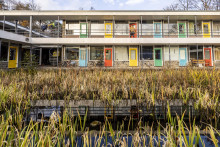In the course of August, the room shortage rapidly developed into a major issue. The situation even led to the Executive Board urgently advising students who did not yet have a room to reconsider their enrolment. After it was announced last week that thirty students can move to the Snuifstraat, a solution now follows for about two hundred remaining room seekers, in the form of a complex of piled up living containers at the Witbreuksweg.
Seven years
The emergency solution is an initiative of Twente Board, the municipality and housing corporations, in consultation with the UT. The plan is for the units to be placed in the course of October, provided that formalities such as applying for a permit are properly completed. The Witbreuksweg was chosen as the location because the infrastructure for the housing is already largely in place there, says UT spokesperson Bertyl Lankhaar. 'The flex -residences are also much less temporary than the accommodation on Snuifstraat,' says Lankhaar. 'As it looks now, these units will be there for the next seven years.'
They are self-contained units, with a surface area of 28 m2. There is room for a kitchen, dining and living room, sleeping area and bathroom. The containers will also have a balcony. The exact rental price is not yet known.
AZC HOUSES
The fact that the infrastructure for the houses is already largely present at the Witbreuksweg has to do with previous temporary student housing. Between 2004 and 2009 there were so-called AZC houses on a plot, originating from an asylum seekers' centre in Uithuizen. At the time, 64 students made use of it.
Urgency and lottery
The residential containers will be placed in phases - fifty units at a time. Matching a student to a house is based on urgency and current travel distance, Lankhaar explains. 'For example, there is priority for students who are currently more than two hours' travel distance, so outside the provinces of Overijssel, Gelderland and Drenthe and the German states of North Rhine-Westphalia and Lower Saxony. There is also an option for a draw, if there appears to be more demand among students in similar situations, compared to the supply of housing at that time.'
According to the spokesperson, the UT attached importance to finding a solution. 'As a university, we could not solve this problem ourselves; we are only allowed to invest in the primary process. But we wanted to talk to parties who could do something about it. If we say that we are the most welcoming university, then we are also doing our best to create the best possible conditions for studying. We are happy that we can solve this together with local partners.'






